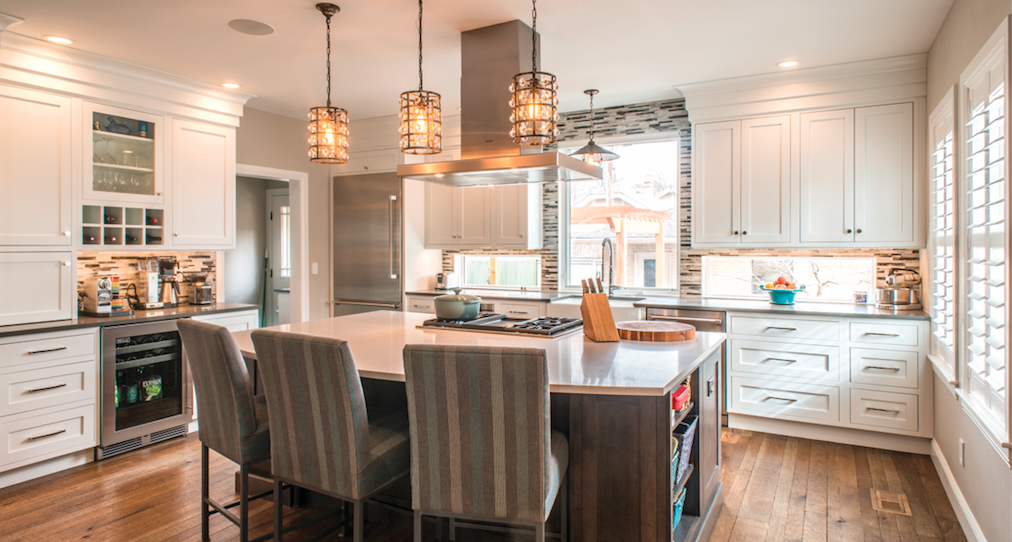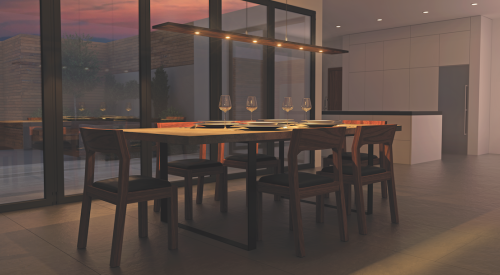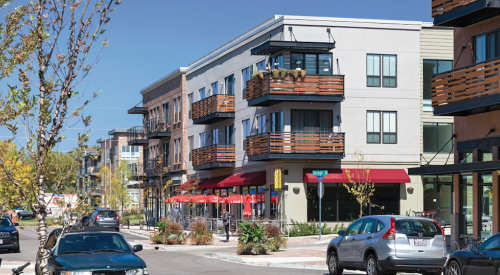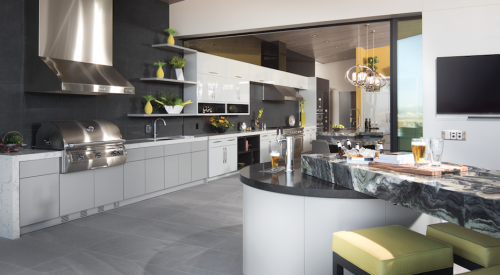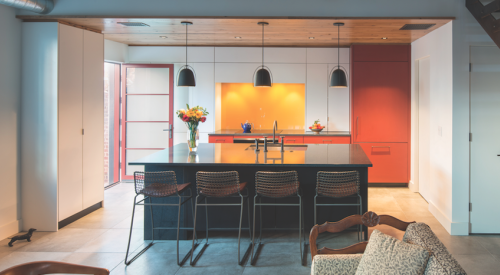Lighting your homes better than the competition is common sense. Your buyers’ comfort, safety, and overall enjoyment is too important to leave to the electrician in the field. But sadly, bad lighting is the norm because code requires only bare minimums. Conforming to that poor standard, however, is a mistake.
What’s the first thing a real estate agent does when showing a home? Turns on the lights. By its nature, light attracts, and that’s an opportunity for you. What’s more, new lighting technology makes it easier than ever to increase light levels in your homes. The arrival of LED lighting is a boon for both builders and buyers. LEDs use 20 percent of the energy used by halogens, put out far less heat, and last at least two decades. Their longevity and low operating cost pay dividends for years, and they’re part of a green story you can sell to your buyers.

In the kitchen, don’t forget the power of daylight, provided here by two skylights. In addition to abundant natural light, five circuits combine to eliminate shadows and provide task, ambient, and decorative light. Project: Colorado Sunroom and Window, Doug Walter Architects. Photo: Phil Wegener Photography
A Necessity, Not an Amenity
You know the numbers: Nearly 80 million Baby Boomers are nearing retirement age. That number will continue to rise for the next 35 years. For home builders, the implications are huge.
Older folks need more light to see: A 60-year-old requires three times as much light as a 20-year-old. The good news is that, with added illumination, a senior’s visual acuity can almost equal their grandchildren’s. Good lighting benefits everyone.
Lighting Basics
There are four types of lighting: ambient, task, decorative, and accent, and one fixture can serve several functions. A dining room chandelier is decorative but also supplies ambient light to the dining room and task lighting to illuminate the table. A recessed can light can be task, ambient, or accent, depending on its location. The best lighting schemes use several, if not all four, types of lighting, taking a layered approach.

Lighting in the Kitchen
No room is more critical for good lighting—and none is more neglected—than the kitchen. The International Residential Code says that one overhead light is enough. No way. Code minimum is totally inadequate. The National Kitchen & Bath Association (NKBA) and the International Illuminating Engineering Society (IESNA) have recommended a minimum light level on countertops of 50 foot-candles (fc). But most countertops measure 10 to 15 fc with all lights blazing.
Too many kitchens are poorly lit because of a misunderstanding of where recessed can lights need to be placed for effective task lighting on countertops. To deliver enough light, cans must be directly above the counters 8 to 12 inches out from upper-cabinet faces. If they are placed farther out, the cook will block the light and the 50 fc you measured without anyone in the way will drop to single digits.
Check photometric charts to see that the cans specified can deliver the 50 fc minimum to the counters. Pay attention to the lamps (bulbs) used (see “Lighting 101.”)
Under-cabinet lighting is a welcome upgrade
It nicely supplements overhead lighting. Look for LED strips that put out more than 500 lumens per foot and you may achieve 40 fc near the front of the counters if you mount the strips properly at the front edge of the upper cabinets. Most 300-to-400-lumens-per-foot under-cabinet lights do 20 fc at best.
Multiple layers of lighting are the best strategy
Decorative pendants set over islands can be combined with well-placed recessed cans to provide more light on the counters. In a large kitchen, it’s not unusual to have a total of 15 or 20 separate fixtures of different types.
Open-plan kitchen/great room circuiting requires planning
You may need four to eight circuits of lighting to adequately light major spaces. Plan how to best divide light circuits. There’s no need to turn on 10 cans when three key cans may work for 80 percent of kitchen tasks. Another upgrade idea is to install a single room-lighting control system that consolidates all switches into one wall plate with, say, five different preset scenes.
Natural daylight is essential
It serves to light the kitchen and provide a connection to the outdoors. More and larger windows, skylights, and French or sliding doors are ideal, and they’re much-desired amenities.

Better Lighting in the Bathroom
Daylight is a boon in the bath because it helps set circadian rhythms, which get you up and going in the morning. Use as many windows, skylights, and solar tubes as possible.
Cross-lighting works best for grooming
Sconces to either side of the bathroom mirror for each user provide the best lighting; linear LEDs are ideal. This cross-lighting ensures there are no shadows, much like actors’ makeup mirrors, but without the exposed bulbs and glare. Overhead lights cast shadows, which isn’t helpful for grooming, but overheads are fine if used in addition to sconces at the sink.
Light the tub or shower
You can use open LED trims that are rated for wet use and put out many times the illumination you’d once have gotten from a lensed 60-watt incandescent.

Lighting in the Living and Family Rooms
Warm, soft ambient lighting is ideal here, with the ability to use task lighting for reading, sewing, and other needs. Close-to-ceiling fixtures, such as drums, which offer uplighting, are good ambient and decorative sources, as are wall sconces and lamps that the owners will supply. Recessed cans aren’t recommended here, but they can provide accent and ambient lighting of walls and corners.
Indirect lighting is ideal in living and family rooms
Some examples: on top of exposed beams in a vaulted ceiling, at the top of drapery valances, or on top of built-ins. Indirect lighting bounced off the ceiling is almost the perfect light because there’s no glare. Use large window groupings, sliding doors, and skylights. They’re upgrades that add drama and abundant daylight.

Lighting for Dining Rooms
Formal dining rooms can be used for more than holiday dinners; they can offer room for a library, homework, or arts and crafts projects. Lighting this room usually includes a chandelier or decorative pendant over the table, but there are great opportunities for additional circuits of lighting.
One simple upgrade is to add more lighting for the table
Two small MR16 cans about 2 feet to either end of the chandelier aimed at the tabletop will enable owners to dim the chandelier but still maintain bright light on the table. Accent lighting is often added, with cans around the perimeter focused on art or furniture against walls.
Ambient lighting, in addition to the chandelier, can be provided by sconces, or cans in four corners of the room whose sole purpose is dropping in even room light independent of light from the chandelier or sconces. If you have a coffered ceiling or coves, this is a great space to introduce indirect LED uplighting. For daylighting, windows or French doors are a terrific addition.
Lighting Stairways, Hallways, and Utility Rooms
More than 1,300 deaths per year in the U.S. are blamed on stair falls. Stairways must be well-lit, day or night. For daytime, try a tubular daylighting device, also called a sun tube, light tube, solar tube, or tubular skylight.
Make sure there are lights at the top and bottom of any stairway and that they are switched together on a three-way switch. An upgrade would be an additional light in the middle of the run. In the homes we design, we always position a plug halfway down the stair for a plug-in night-light and for vacuuming.
Hallways should be well-lit and not too dark compared with adjacent rooms, especially for seniors, whose eyes take longer to adjust to differences in light level. Recessed cans are great here: They deliver light without glare and can highlight art or photographs on the walls.
Walk-in closets benefit from a dimmable linear LED wrap-around for maximum brightness, and a recessed can or small surface fixture for dim lighting for a quick in and out. If there are shallow wall closets, mounting a small LED strip above the head of the door on the inside that’s switched either with a door switch or wall switch is an easy upgrade. Another great upgrade for seniors is to put motion-sensor switches in closets, pantries, and garages so there’s no need to fumble for the light switch.

Bedrooms need soft, layered lighting and bedside lamps. Downlights offer ambient and accent lighting; warm cove lighting offers mood lighting. All circuits are on dimmers with three-way switches by the door and the bed. Project: Reconstruction Experts, Andrea Lawrence Woods Interiors, Doug Walter Architects. Photo: Philip Wegener Photography
Bedroom Lighting
This room is often overlooked when it comes to lighting. At best, you’ll find a center fixture or fan with a light, and some half-switched outlets for bedside lamps. But this is supposed to be the owners’ oasis and, as such, it deserves special lighting, primarily ambient and decorative.
If the ceilings are 9 feet or more, pendants that have an uplighting component are ideal, as are sconces or cove lighting. If the ceiling is vaulted, you can use uplight sconces on the tall walls, bouncing indirect lighting off the ceiling. For secondary bedrooms, a shielded center fixture in the ceiling plus perhaps a closet light would be a welcome upgrade.
Choose a warm 2700K light source to encourage sleep. The only task lighting in the bedroom will be bedside lamps or wall sconces. Sometimes small-diameter reading lights can be used in the ceilings, much like on an airplane. Large window groupings or sliding doors offer lots of daylight, and they’re an oft-requested upgrade.
Lighting 101—a primer on what makes for good-quality lighting
- Color temperature is measured on the Kelvin scale—warmer temperatures (2700K) are orange-red, such as traditional incandescent bulbs; cooler temperatures (5000K) are bluish. Cool light gets us going in the morning, but too much of it in the afternoon or evening makes it hard to calm down and go to sleep. A neutral, slightly warm white (3000K) is a nice compromise and is pleasant in most residential rooms. Bedrooms are the exception: 2700K may be preferable there.
- Quality of light is measured on a color rendering index (CRI)—a scale from 0 to 100 percent indicating how accurate a given light source is at rendering color when compared with a reference light source, where 100 is ideal. Most artificial light doesn’t get there, but 90 is considered an excellent CRI. Industrial and street light bulbs, such as high-pressure sodium (HPS) bulbs, have a low CRI of around 40. To see high CRI in action, visit the produce or meat section at a store like Whole Foods, which uses lighting to make food look appetizing.
- Light output at the fixture is measured in lumens. No longer do we compare lights based on wattage because it’s falling every year as LEDs become more efficient. Lumens are what’s listed on the Lighting Facts label on the box bulbs come in. It’s misleading, though, as it doesn’t tell you how much light will make it down to the surface you’re trying to illuminate.
- The amount of light that arrives on the surface you intend to illuminate is measured in foot-candles (fc). Don’t buy an expensive meter; free apps for mobile devices do a good job, and photometric charts are helpful, too. To give a sense of numbers, NKBA recommends light levels at kitchen counters of at least 50 fc.
- Bulb types, also known as lamps, really matter. You’re familiar with A lamp bulbs—the traditional Edison bulb. But they’re only appropriate in decorative fixtures. In recessed cans, BR (bulged reflector) lamps are most commonly used, but they’re far less effective at delivering usable illumination to the countertop than are PAR (parabolic reflector) lamps. Tests on my jobsites have shown that a PAR lamp can deliver five to 10 times as many foot-candles as a BR lamp of identical wattage and lumen output. The foot-candles on one client’s countertops jumped from 15 to 158 when I substituted PAR for BR lamps.
Field Tips for Lighting Design
Integrating lighting into the early stages of design can translate to good sales results. For those in the field:
• Mock it up. For a model or prototype home, test light levels during the build by mocking up or temporarily powering up circuits before drywall to see if cans need to be moved or added. For a custom home, you can model lighting schemes on the computer and know what you’ll get before it’s even installed. My lighting consultant uses AGi32, a calculating tool for accurate photometric projections.
• Dim it down. Put dimmers on most major circuits—especially in kitchens, family rooms, and bathrooms—to give users choice of light levels. Not everyone wants the same light level. Dimming LEDs, like halogens, extends already impressive lamp life even more.
• Beware the glare. When you increase the quantity of light, make sure you aren’t increasing glare. Good lighting is glare-free, and you should never be looking directly at the light source without a lens or frosted shade.
• Ask the experts. Team up with people who know this stuff, such as lighting designers, architects, interior designers, and kitchen designers who have a subspecialty in lighting. Find consultants who keep up with the industry and attend not only the IBS and KBIS trade shows, but especially Lightfair International, the annual conference for true-blue lighting aficionados.
Doug Walter, an architect in Denver, has a passion for good lighting.
